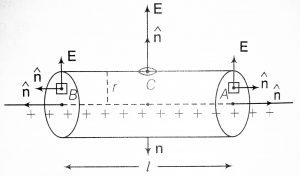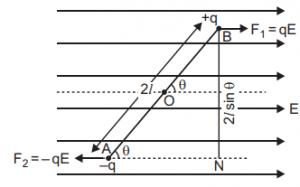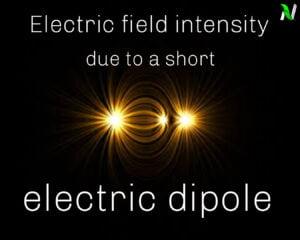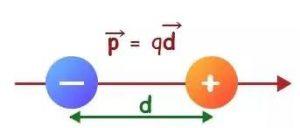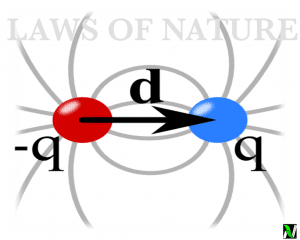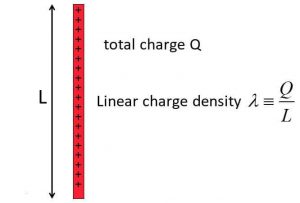BASIC CONCEPT OF ELECTRIC FLUX
Electric flux is a very important topic of electromagnetism. So it is very important for us that we understood it’s basic concept. In this physics article, we are going to discuss about electric flux. Before we start discussing about electric flux, let’s brush up the concept of electric field.
BASICS OF ELECTRIC FIELD
We know that every charge particles acquired a three dimensional space around itself in which if any other charged particles came then it experience a electrostatic force. This three dimensional region around any charged particle is called electric field. Which is denoted as capital E. Which is given as –
[latexpage]
$$
E = \frac{1}{4\pi\epsilon_0}\frac{q}{r^2}
$$ where q is charge and r is the distance of the point where electric field is to be obtained.
But do you ever see that electric field around any charged particles. Absolutely not. Because there is no physical meaning of electric field. For our convenience, we describe electric field in pictorial form. We draw electric field as dotted line or solid line. Which is sometimes called electric field lines or electric lines of force or gauss lines.
If charge particle is positive then it’s electric field lines are radially outward but if it negative then it’s line of force are radially inward.
MEANING OF FLUX
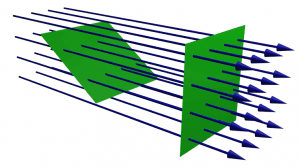
Flux has different meaning in different branches of science. In electromagnetism usually the meaning of flux is that ” It is the measure of how much of the field passes through a given area. In fluid mechanics flux is defined as ” The rate of flow of property per unit area. In simple terms flux is the measurement of how much something coming out of an unit area.
ELECTRIC FLUX
Now let’s talk about electric flux. We have just learned that what flux is. But if we want to understand electric flux, then we can understand it very easily. From the definition of flux. We can define electric flux. Electric flux is the measure of how much electric field lines is passing through a unit area. Similarly we can define magnetic flux too, magnetic flux is the measure of how much magnetic field lines is passing through a unit area.
If there large numbers of electric field lines are passing through a unit area then there will be large value of electric flux. But if the number of electric lines is less then the value of electric flux will also decrease. Density of electric field lines corresponds to the strength of electric field. Higher density stronger electric field lower density weaker electric field.
Density of electric field lines will also affect the value of electric flux because electric flux is directly proportional to the numbers of electric field lines going through a unit area. Keep in mind that for our simplicity we often take area perpendicular to the field lines.
ELECTRIC FLUX FORMULA
FOR UNIFORM SOURCE

Assume a source which produce a uniform electric field of magnitude E and if it is passing through a area vector S. Then the value of electric flux is –
\begin{equation}
\Phi_{E} = E.S = ES\cos\theta
\end{equation} where E is the magnitude electric field (having units V/m), S is the surface area, and θ is the angle between the electric field lines and the normal (perpendicular) to S.
FOR NON – UNIFORM SOURCE
If the source produce a non – uniform electric field of magnitude E, then the small electric flux $d\Phi_{E}$ is given as, when it is passing through a small area element dS –
\begin{equation}
d\Phi_{E} = E.dS = EdS\cos\theta
\end{equation}
The electric flux over a whole surface S is therefore given by the surface integral –
\begin{equation}
\Phi_{E} = \iint_{S}{\mathbf{E}}.d{\mathbf{S}}
\end{equation}
where E is the magnitude of electric field and dS is a small area element on the closed surface S with an outward facing surface normal defining its direction.
FOR CLOSED GAUSSIAN SURFACE
For closed Gaussian surface electric flux is given as –
\begin{equation}
\Phi_{E}=\oiint_{S}{\mathbf{E}}.d{\mathbf{S}}=\frac{Q}{\epsilon_0}
\end{equation}
E is the electric field, S is any closed surface, Q is the total electric charge inside the surface S, $\epsilon_0$ is the electric constant (a universal constant, also called the “permittivity of free space”) ($\epsilon_0$ ≈ 8.854 187 817… x 10−12 farads per meter (F·$m^{-1}$)).
Electrical flux has SI units of volt meters (Vm), or equivalently, newton meters squared per coulomb ($Nm^{2}C^{-1}$). Thus, the SI base units of electric flux are [kg$m^{3}s^{-3}A^{-1}$]. Its dimensional formula is [$ML^3T^{-3}I^{-1}$].

